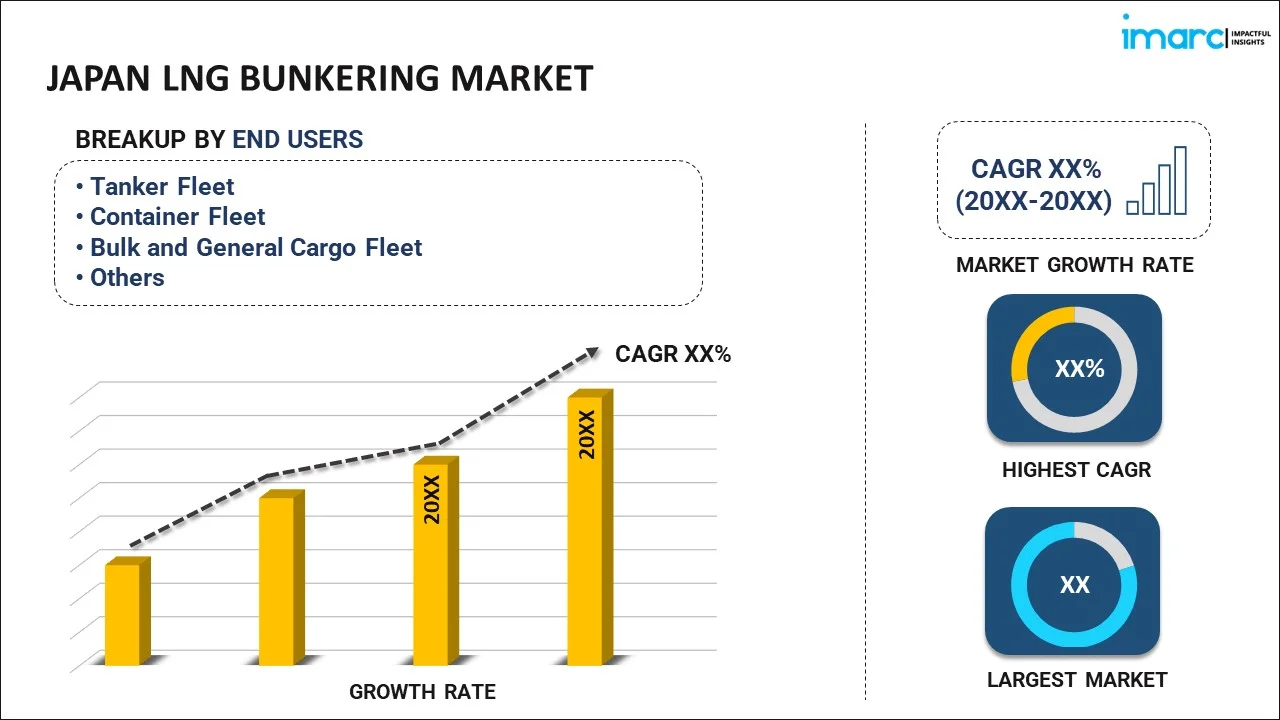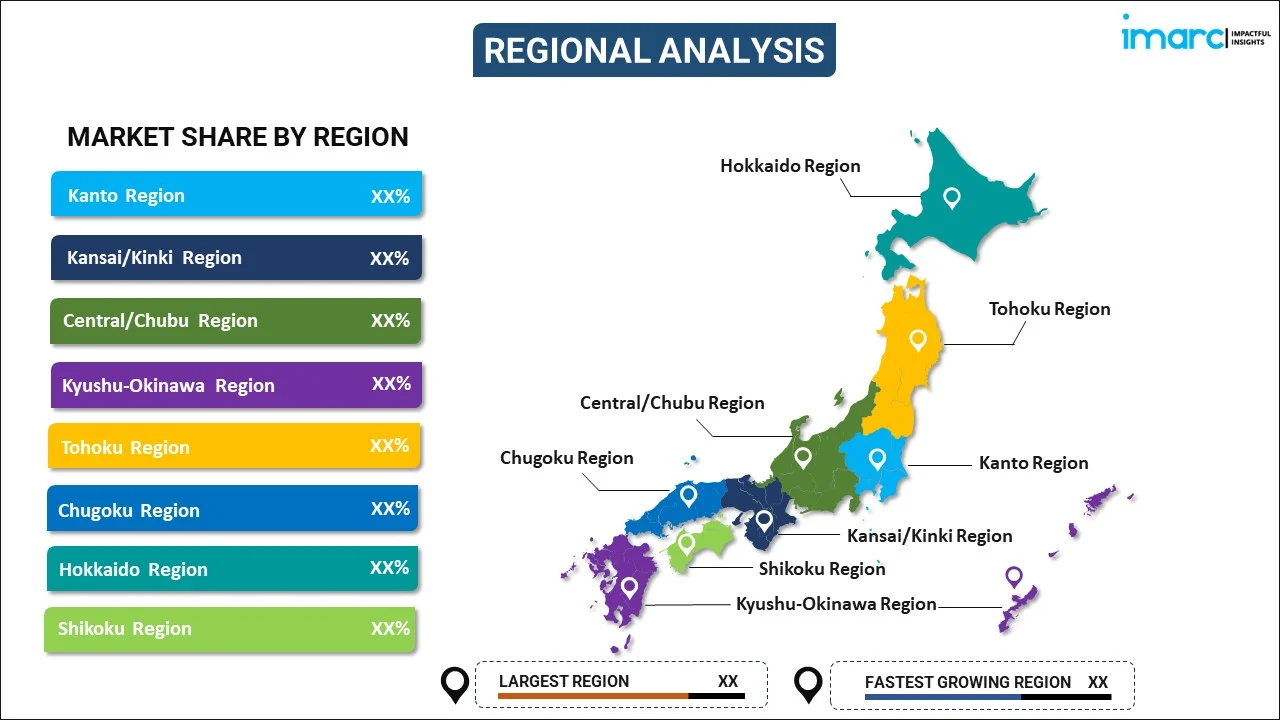
Japan LNG Bunkering Market Report by End User (Tanker Fleet, Container Fleet, Bulk and General Cargo Fleet, Ferries and OSV, and Others), and Region 2025-2033
Market Overview:
Japan LNG bunkering market size reached USD 187.4 Million in 2024. Looking forward, IMARC Group expects the market to reach USD 311.3 Million by 2033, exhibiting a growth rate (CAGR) of 5.8% during 2025-2033. The increasing regional focus on environmental sustainability and the need to reduce greenhouse gas emissions in the shipping industry is primarily driving the LNG bunkering market growth.
|
Report Attribute
|
Key Statistics
|
|---|---|
|
Base Year
|
2024 |
|
Forecast Years
|
2025-2033 |
|
Historical Years
|
2019-2024
|
| Market Size in 2024 | USD 187.4 Million |
| Market Forecast in 2033 | USD 311.3 Million |
| Market Growth Rate (2025-2033) | 5.8% |
LNG bunkering is the procedure of supplying liquefied natural gas (LNG) as a fuel source for ships, encompassing the loading and distribution of LNG into their onboard tanks. Compliance with sulfur content regulations is a crucial aspect of LNG fuel bunkering, as it ensures adherence to environmental standards. LNG, renowned for its lower sulfur content and minimal processing requirements to meet sulfur regulations, is increasingly adopted as an eco-friendly alternative to traditional ship fuels. One of the primary advantages of LNG as a marine fuel is its remarkable capacity to immediately reduce emissions of sulfur and particulate matter to nearly negligible levels. This transition to LNG as a primary marine fuel delivers a multitude of benefits. Notably, it leads to a substantial reduction in shipping-related emissions, contributing to a cleaner environment. Additionally, LNG offers cost advantages through lower operating and shipment expenses, enhancing the economic viability of this sustainable fuel option. Furthermore, LNG is considered a safer and non-toxic fuel, further bolstering its appeal in the maritime industry.
Japan LNG Bunkering Market Trends:
The LNG bunkering market in Japan is predominantly influenced by the increasing adoption of LNG as a preferred fuel for shipping, driven by a heightened emphasis on sustainable development. This shift is primarily driven by stringent environmental regulations aimed at reducing sulfur content in marine fuel and mitigating pollution from maritime transportation. Additionally, continuous improvements in LNG distribution infrastructure are bolstering market growth. A substantial uptick in regional gas exploration and production activities further contributes to the positive outlook for the LNG market. The market's momentum is also fueled by a significant rise in the use of truck-to-ship LNG bunkering methods in Japan. Furthermore, the ready availability of LNG bunker fuel in major maritime hubs is exerting a positive impact. The introduction of LNG-powered vessels has spurred the rapid expansion of LNG manufacturing and storage facilities, serving as a significant driver for market expansion. Numerous other factors driving the growth of the market encompass rapid urbanization and industrialization trends, mounting concerns about fossil fuel depletion, and extensive R&D initiatives undertaken by key industry players.
Japan LNG Bunkering Market Segmentation:
IMARC Group provides an analysis of the key trends in each segment of the market, along with forecasts at the country level for 2025-2033. Our report has categorized the market based on end user.
End User Insights:

- Tanker Fleet
- Container Fleet
- Bulk and General Cargo Fleet
- Ferries and OSV
- Others
The report has provided a detailed breakup and analysis of the market based on the end user. This includes tanker fleet, container fleet, bulk and general cargo fleet, ferries and OSV, and others.
Regional Insights:

- Kanto Region
- Kansai/Kinki Region
- Central/ Chubu Region
- Kyushu-Okinawa Region
- Tohoku Region
- Chugoku Region
- Hokkaido Region
- Shikoku Region
The report has also provided a comprehensive analysis of all the major regional markets, which include Kanto Region, Kansai/Kinki Region, Central/ Chubu Region, Kyushu-Okinawa Region, Tohoku Region, Chugoku Region, Hokkaido Region, and Shikoku Region.
Competitive Landscape:
The market research report has also provided a comprehensive analysis of the competitive landscape in the market. Competitive analysis such as market structure, key player positioning, top winning strategies, competitive dashboard, and company evaluation quadrant has been covered in the report. Also, detailed profiles of all major companies have been provided.
Japan LNG Bunkering Market Report Coverage:
| Report Features | Details |
|---|---|
| Base Year of the Analysis | 2024 |
| Historical Period | 2019-2024 |
| Forecast Period | 2025-2033 |
| Units | Million USD |
| Scope of the Report | Exploration of Historical Trends and Market Outlook, Industry Catalysts and Challenges, Segment-Wise Historical and Future Market Assessment:
|
| End Users Covered | Tanker Fleet, Container Fleet, Bulk and General Cargo Fleet, Ferries and OSV, Others |
| Regions Covered | Kanto Region, Kansai/Kinki Region, Central/Chubu Region, Kyushu-Okinawa Region, Tohoku Region, Chugoku Region, Hokkaido Region, Shikoku Region |
| Customization Scope | 10% Free Customization |
| Post-Sale Analyst Support | 10-12 Weeks |
| Delivery Format | PDF and Excel through Email (We can also provide the editable version of the report in PPT/Word format on special request) |
Key Questions Answered in This Report:
- How has the Japan LNG bunkering market performed so far and how will it perform in the coming years?
- What has been the impact of COVID-19 on the Japan LNG bunkering market?
- What is the breakup of the Japan LNG bunkering market on the basis of end user?
- What are the various stages in the value chain of the Japan LNG bunkering market?
- What are the key driving factors and challenges in the Japan LNG bunkering?
- What is the structure of the Japan LNG bunkering market and who are the key players?
- What is the degree of competition in the Japan LNG bunkering market?
Key Benefits for Stakeholders:
- IMARC’s industry report offers a comprehensive quantitative analysis of various market segments, historical and current market trends, market forecasts, and dynamics of the Japan LNG bunkering market from 2019-2033.
- The research report provides the latest information on the market drivers, challenges, and opportunities in the Japan LNG bunkering market.
- Porter's five forces analysis assist stakeholders in assessing the impact of new entrants, competitive rivalry, supplier power, buyer power, and the threat of substitution. It helps stakeholders to analyze the level of competition within the Japan LNG bunkering industry and its attractiveness.
- Competitive landscape allows stakeholders to understand their competitive environment and provides an insight into the current positions of key players in the market.
Need more help?
- Speak to our experienced analysts for insights on the current market scenarios.
- Include additional segments and countries to customize the report as per your requirement.
- Gain an unparalleled competitive advantage in your domain by understanding how to utilize the report and positively impacting your operations and revenue.
- For further assistance, please connect with our analysts.
 Inquire Before Buying
Inquire Before Buying
 Speak to an Analyst
Speak to an Analyst
 Request Brochure
Request Brochure
 Request Customization
Request Customization




.webp)




.webp)












